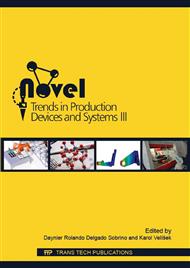[1]
W. Zebala. Modeling of cutting process, Krakow (2011).
Google Scholar
[2]
J. Chodor, L. Kukielka. Numerical analysis of micromachining of C45 steel with single abrasive grain, GAMM 79th Annual Meeting of the International Association of Applied Mathematics and Mechanics, E-Publishing, Bremen, (2008).
DOI: 10.1002/pamm.200810715
Google Scholar
[3]
J. Chodor, L. Kukielka. Numerical analysis of the influence of abrasive grain geometry and cutting angle on states of strain and stress in the surface layer of object, in J.T.M. De Hosson, C.A. Brebbia, S-I Nishida (Eds. ), Computer Methods and Experimental Measurements for Surface Effects and Contact Mechanics VIII, WITPRESS, Ashurst, Southampton, United Kingdom, 2007, pp.183-193.
DOI: 10.2495/secm070181
Google Scholar
[4]
B. Storch, J. Chodor, L. Kukielka, New method of determination of tool rake angle on the basis of crack angle of specimen in tensile test and numerical simulations, in J.T.M. De Hosson, C.A. Brebbia (Eds. ), Surface Effects and Contact Mechanics IX: Computational Methods and Experiments, WITPRESS, Ashurst, Southampton, United Kingdom, 2009, pp.207-216.
DOI: 10.2495/secm090191
Google Scholar
[5]
J. Chodor, L. Kukielka. Numerical analysis of chip formation during machining for different value of failure strain. Journal PAMM, Volume 7, Issue 1, pp.4030031-4030032, (2008).
DOI: 10.1002/pamm.200700832
Google Scholar
[6]
J. Chodor, M. Forysiewicz, L. Kukielka. Numerical analysis of flash and chip creating for elasto/visco-plastic body in the process of wedge movement, XXXIV Scientific School of Abrasive Machining, Gdansk, 2011. (In Polish).
Google Scholar
[7]
M. Forysiewicz, J. Chodor, L. Kukielka. Discrete modeling and numerical analysis of the process of cutting with a single abrasive grain using finite element method. Numerically controlled machine tools and techniques programming in manufacturing operations. Printing in Radom University of Technology, Radom, 2009. (In Polish).
Google Scholar
[8]
L. Kukielka, K. Kukielka. Modeling and analysis of the technological processes using finite element method, Mechanik (2015).
Google Scholar
[9]
J. Chodor, L. Kukielka. The use of nonlinear contact mechanics in analysis of the movement of the machined workpiece during cutting and sliding burnishing, Mechanik 8-9/2014. (In Polish).
DOI: 10.4028/www.scientific.net/amm.474.339
Google Scholar
[10]
J. Chodor, L. Kukielka. Using Nonlinear Contact Mechanics in Process of Tool Edge Movement on Deformable Body to Analysis of Cutting and Sliding Burnishing Processes, Applied Mechanics and Materials, Vol 474, pp.339-344, Jan. (2014).
DOI: 10.4028/www.scientific.net/amm.474.339
Google Scholar
[11]
J. Chodor, L. Zurawski. Researches of chip shape and its swage factor and shortening factor in partial symmetric face milling process and simulation of the process using FEM, Mechanik 03/(2015).
DOI: 10.17814/mechanik.2015.3.146
Google Scholar
[12]
L. Bohdal, L. Kukielka. Optimization of the dynamic blanking process. PAMM, Proc. Appl. Math. Mech. 7: 4030043–4030044, (2007).
DOI: 10.1002/pamm.200701126
Google Scholar
[13]
R. Patyk, L. Kukielka, K. Kukielka, A. Kulakowska, L. Malag, L. Bohdal. Incremental Modelling and Numerical Solution of the Contact Problem between Movable Elastic and Elastic/Visco-Plastic Bodies and Application in the Technological Processes. Applied Mechanics and Materials Novel Trends in Production Devices and Systems, Editors: Karol Velíšek, Peter Košťál and Milan Nad, 2014, USA-SLOVAKIA, pp.159-165.
DOI: 10.4028/www.scientific.net/amm.474.159
Google Scholar
[14]
A. Kulakowska, L. Kukielka, K. Kukielka, R. Patyk, L. Malag, L. Bohdal. 3D Numerical Analysis the State of Elastic/Visco-Plastic Strain in the External Round Thread Rolled on Cold. Applied Mechanics and Materials Novel Trends in Production Devices and Systems, Editors: Karol Velíšek, Peter Košťál and Milan Nad, 2014, USA-SLOVAKIA, pp.436-441.
DOI: 10.4028/www.scientific.net/amm.474.436
Google Scholar


